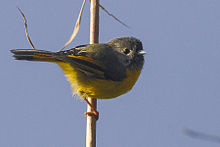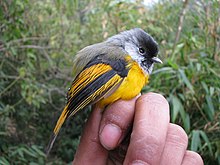Golden-breasted fulvetta
| Golden-breasted "fulvetta" | |
|---|---|

| |
| Pangolakha WLS in East Sikkim, India. | |
| Scientific classification | |
| Domain: | Eukaryota |
| Kingdom: | Animalia |
| Phylum: | Chordata |
| Class: | Aves |
| Order: | Passeriformes |
| Family: | Paradoxornithidae |
| Genus: | Lioparus Oates, 1889 |
| Species: | L. chrysotis
|
| Binomial name | |
| Lioparus chrysotis (Blyth, 1845)
| |
| Synonyms | |
| |
The golden-breasted fulvetta (Lioparus chrysotis) is a species of songbird found in Bhutan, China, India, Myanmar, Nepal, and Vietnam. Its natural habitats are temperate forests and subtropical or tropical moist montane forests.
Taxonomy[edit]
| Phylogenetic position of the genus Lioparus[2] |
When Edward Blyth first described the golden-breasted fulvetta in 1845, from a written description provided by naturalist Brian Houghton Hodgson of a specimen collected in Nepal, he gave it the scientific name Proparus chrysotis.[3][nb 1] Most ornithologists kept it in that genus until 1889, when Eugene William Oates created the genus Lioparus and named the golden-breasted fulvetta as its type species and sole member. He moved the species out of the genus Proparus because it had a broader bill, much longer rictal bristles (bristles hanging over the nostrils) and smaller hind claws than other species in the genus.[5][6][7] There are six recognized subspecies:[8]
- L. c. chrysotis, the nominate subspecies, is found from central Nepal east to northeastern India (western Arunachal Pradesh) and adjacent southern China (southeastern Xizang).[8] This has a grey chin and throat with silvery white tips to the feathers, a coal grey head and either lacking or having a narrow white median crown or coronal stripe.[9][10] Some Sikkim specimens have a grey coronal stripe.[11]
- L. c. albilineatus, described by Walter Koelz in 1954, is found in Assam, Nagaland and Manipur in northeastern India.[8] Said to have a prominent white coronal stripe and brighter plumage.[12][13]
- L. c. forresti, described by Walter Rothschild in 1926, is found in northeastern Myanmar and northwestern Yunnan (in southern China).[8] They have the coronal stripe made up of white spots which are yellowish towards the nape. It is named after the collector of the type specimen, George Forrest.[11]
- L. c. swinhoii, described by Jules Pierre Verreaux in 1871, is found in China from southeastern Gansu, southern Shaanxi and central Sichuan south to Guangxi, southeastern Hunan and northern Guangdong.[8]
- L. c. amoenus, described by Ernst Walter Mayr in 1941, is found in southeastern Yunnan and Tonkin in northwestern Vietnam.[8]
- L. c. robsoni, described by J. C. Eames in 2002, is found in central Vietnam.[8] It has a yellow throat and chin, an off-white central crown stripe and olive-grey ear coverts.[10]
Description[edit]

The golden-breasted fulvetta is a small bird, measuring 10–11.5 cm (3.9–4.5 in) in length[nb 2] with a mass between 5 and 10 g (0.18 and 0.35 oz).[8] The head and crown are black or grey and the black wings have orange-yellow slashes. The secondaries are tipped white and brown tail has two thirds of the base edged in orange yellow. The underparts are predominantly yellow and the throat may be grey or yellowish depending on the populations. The presence, prominence and colour of the median crown stripe varies with populations. The sexes are indistinguishable by plumage.[13][15]
Range and habitat[edit]
The golden-breasted fulvetta is found from central Nepal through Bhutan, northern India and Myanmar to western China and northern Vietnam. It is an altitudinal migrant, moving from breeding grounds at 2,000–2,800 m (6,600–9,200 ft) to foothills as low as 1,600 m (5,200 ft), and occasionally down to 1,300 m (4,300 ft), in the winter.[16]
Golden-breasted fulvettas are found in broad-leaved evergreen forests and montane bamboo where they forage at a low height for insects, moving in groups of as many as 30 individuals in winter, and often joining mixed-species foraging flocks.[15]
Conservation and threats[edit]
The International Union for Conservation of Nature (IUCN) lists the golden-breasted fulvetta as a species of least concern. Although its population has not been quantified and is thought to be declining, the decline is not thought to be precipitous, and its overall range is vast.[1] In recent times, there has been growing pressure on some populations, with people collecting them as a food source or as pets.[17]
Several species of feather mite have been described from specimens of the golden-breasted fulvetta including Timalinyssus grallator,[18] Neocalcealges chrysotis, Anhemialge lioparus and Resartor extraneus from China.[19][20][21]
Notes[edit]
References[edit]
- ^ a b "Golden-breasted Fulvetta: Summary". BirdLife International. Retrieved 4 May 2019.
- ^ Cai, Tianlong; Cibois, Alice; Alström, Per; Moyle, Robert G.; Kennedy, Jonathan D.; Shao, Shimiao; Zhang, Ruiying; Irestedt, Martin; Ericson, Per G.P.; Gelang, Magnus; Qu, Yanhua; Lei, Fumin; Fjeldså, Jon (2019). "Near-complete phylogeny and taxonomic revision of the world's babblers (Aves: Passeriformes)" (PDF). Molecular Phylogenetics and Evolution. 130: 346–356. doi:10.1016/j.ympev.2018.10.010. PMID 30321696.
- ^ Blyth, Edward (1844). "Synopsis of Indian Fringillidae". J. Asiatic Soc. Bengal. XIII (156): 944–963.
- ^ Dickinson, Edward C.; Pittie, Aasheesh (2006). "Systematic notes on Asian birds. 51. Dates of avian names introduced in early volumes of the Journal of the Asiatic Society of Bengal". Zool. Med. Leiden. 80.
- ^ Blanford, W. T., ed. (1888–1891). The Fauna of British India, Including Ceylon and Burma. London, UK: Taylor and Francis. p. 174.
- ^ Hodgson, B. H. (1844). "On the Leiotrichane birds of the Subhemalayas" by B.H. Hodgson, Esq.: with some additions and annotations, —a synopsis of the Indian Pari, —and of the Indian Fringillidæ by E. Blyth". Journal of the Asiatic Society of Bengal. 13 (2) (published 1845): 933–944.
- ^ Oates, E.W. (1889). The Fauna of British India, including Ceylon and Burma. Birds. Volume I. London: Taylor and Francis. p. 174.
- ^ a b c d e f g h "Golden-breasted Fulvetta (Lioparus chrysotis)". Handbook of Birds of the World Alive. Retrieved 4 May 2019.
- ^ Yen, K.Y. (1936). "Revision du genre Alcippe Blyth 1844". L'Oiseau et la Revue française d'ornithologie. 6 (3): 435–454.
- ^ a b Eames, J.C. (2002). "Eleven new sub-species of babbler (Passeriformes: Timaliinae) from Kon Tum Province, Vietnam". Bulletin of the British Ornithologists' Club. 122: 109–141.
- ^ a b Rothschild, Lord (1926). "Exhibition and description of a new subspecies of Fulvetta (Fulvetta chrysotis forresti) from Yunnan". Bulletin of the British Ornithologists' Club. 46: 64.
- ^ Koelz, Walter (1954). "Ornithological studies I. New birds from Iran, Afghanistan, and India". Contributions from the Institute for Regional Exploration. 1: 1–32.
- ^ a b Ali, S.; Ripley, S.D. (1996). Handbook of the Birds of India and Pakistan. Volume 7. Laughing Thrushes to the Mangrove Whistler (2 ed.). Delhi: Oxford University Press. pp. 109–110.
- ^ Cramp, Stanley, ed. (1977). Handbook of the Birds of Europe, the Middle East and North Africa: Birds of the Western Palearctic, Volume 1, Ostrich to Ducks. Oxford, UK: Oxford University Press. p. 3. ISBN 978-0-19-857358-6.
- ^ a b Rasmussen, P.C.; Anderton, J.C. (2005). Birds of South Asia. The Ripley Guide. Volume 2. Smithsonian Institution and Lynx Edicions. pp. 452–453.
- ^ Spiereburg, Peter (2005). Birds in Bhutan: Status and Distribution. Bedford, UK: Oriental Bird Club. p. 307. ISBN 978-0-9529545-1-4.
- ^ "Golden-breasted Fulvetta: Data table and detailed info". BirdLife International. Retrieved 6 May 2019.
- ^ Mironov, S.V.; Proctor, H.C. (2011). "Four new feather mite species of the family Pteronyssidae (Astigmata: Analgoidea) from Laughing-Thrushes (Passeriformes: Timaliidae) in China" (PDF). Acarina. 19: 35–51.
- ^ Wang, ZI-Ying; Proctor, Heather (2015). "Two new feather mites of the genus Neocalcealges Orwig (Analgoidea: Trouessartiidae) from the Sichuan province of China". Zootaxa. 3946 (4): 567–76. doi:10.11646/zootaxa.3946.4.5. PMID 25947709.
- ^ Chang, HUI-QUN; Wang, ZI-Ying; Liu, Huai (2018). "Four new feather mite species of the genus Anhemialges Gaud, 1958 (Astigmata: Analgidae) from China". Zootaxa. 4531 (2): 251–265. doi:10.11646/zootaxa.4531.2.6. PMID 30651445.
- ^ Gustafsson, Daniel Roland; Chu, Xingzhi; Bush, Sarah Elizabeth; Zou, Fasheng (2018). "Seven new species of Resartor Gustafsson et Bush, 2017 (Phthiraptera: Ischnocera: Philopteridae) from Asian ʻbabblers' (Passeriformes: Leiothrichidae, Paradoxornithidae)" (PDF). Folia Parasitologica. 65. doi:10.14411/fp.2018.020. PMID 30593007.

